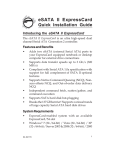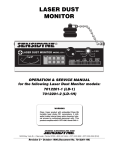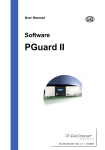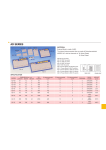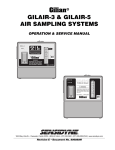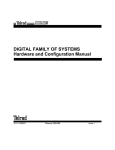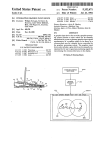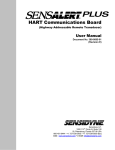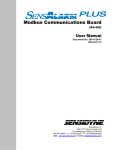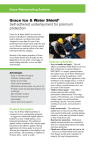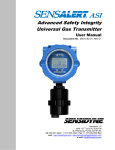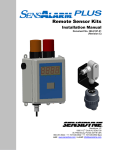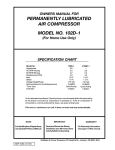Download 4ch Controller manual 7013227r
Transcript
FOUR CHANNEL CONTROLLER Document No. 7013227M (Revision H) LO HI LO HI HI HI HI HI CH 1 CH 2 FAULT FAULT METHANE 9 %LEL OXYGEN 19.3 %VOL POWER AC PWR LO HI DC PWR BACK UP HI HI ▼ HI HI HI CH 3 CH 4 FAULT FAULT CHLORINE 0.3 PPM RESET BUTTON LO AMMONIA 19 PPM • Push RESET to unlatch a LATCHED ALARM • Push RESET to silence a local LO ALARM • Push RESET for 5 seconds to enter CAL MODE (Push RESET again to exit CAL MODE) Sensidyne, LP 1000 112th Circle N, Suite 100 St. Petersburg, Florida 33716 USA (800) 451-9444 • (727) 530-3602 • Fax: (727) 539-0550 web: www.sensidyne.com • e-mail: [email protected] SENSALERT FOUR CHANNEL CONTROLLER PACKING LIST & NOTICES The items listed below are shipped with the SensAlert Four Channel Controller: • 4–20 mA controller with built-in readout displays, housed in a NEMA 4X fiberglass enclosure. • Operation and Service Manual Always check to make certain you have received all of the items listed above. If you have any questions or need assistance, contact your Sensidyne Representative, or call (800) 451-9444 or (727) 530-3602 PROPRIETARY NOTICE This manual was prepared by Sensidyne, LP exclusively for the owner of the SensAlert Four Channel Controller. The material within this manual is the proprietary information of Sensidyne, LP and is to be used only to understand, operate, and service the instrument. By receiving this document, the recipient agrees that neither this document nor the information disclosed within nor any part shall be reproduced or transferred, physically, electronically or in any form or used or disclosed to others for manufacturing or for any other purpose except as specifically authorized in writing by Sensidyne, LP. COPYRIGHT NOTICE © 2002, © 2008 Sensidyne, LP. All rights reserved. Information contained in this document is protected by copyright. No part of this document may be photocopied, reproduced, or translated to another program or system without prior written authorization from Sensidyne, LP. TRADEMARK NOTICE Sensidyne, the Sensidyne logo, SensAlert, and the SensAlert logo are registered trademarks of Sensidyne, LP. SensAlarm is a trademark of Sensidyne, LP. The trademarks and service marks of Sensidyne, LP are protected through use and registration in the United States. SOFTWARE LICENSE The software included with the SensAlert is the property of Sensidyne, LP and shall remain the property of Sensidyne, LP in perpetuity. The software is protected by U.S. and international copyright laws and is licensed for specific use with the SensAlert Four Channel Controller. The user may NOT reverse-engineer, disassemble, decompile, or make any attempt to discover the source code of the software. The software may NOT be translated, copied, merged or modified in any way. The user may NOT sublicense, rent, or lease any portion of the software. The right to use the software terminates automatically if any part of this license is violated. DISCLAIMER SENSIDYNE, LP ASSUMES NO RESPONSIBILITY WHATSOEVER, TO ANY PARTY WHOSOEVER, FOR ANY PROPERTY DAMAGE, PERSONAL INJURY, OR DEATH RECEIVED BY OR RESULTING FROM, IN WHOLE, OR IN PART, THE IMPROPER USE, INSTALLATION, OR STORAGE OF THIS PRODUCT BY THE USER, PERSON, FIRM, ENTITY, CORPORATION OR PARTY NOT ADHERING TO THE INSTRUCTIONS AND WARNINGS OR NOT ADHERING TO ALL FEDERAL, STATE, AND LOCAL ENVIRONMENTAL AND OCCUPATIONAL HEALTH AND SAFETY LAWS AND REGULATIONS. THE SELLER SHALL NOT BE LIABLE FOR DIRECT, INDIRECT, CONSEQUENTIAL, INCIDENTAL OR OTHER DAMAGES RESULTING FROM THE SALE AND USE OF ANY GOODS AND SELLER’S LIABILITY HEREUNDER SHALL BE LIMITED TO REPAIR OR REPLACEMENT OF ANY GOODS FOUND DEFECTIVE. THIS WARRANTY IS IN LIEU OF ALL OTHER WARRANTIES, EXPRESSED OR IMPLIED, INCLUDING BUT NOT LIMITED TO THE IMPLIED WARRANTIES OF MERCHANTABILITY AND FITNESS FOR USE OR FOR A PARTICULAR PURPOSE WHICH ARE EXPRESSLY DISCLAIMED. Sensidyne Document No. 7013227M (Rev H) PRELIMINARY 3 SENSALERT FOUR CHANNEL CONTROLLER TABLE OF CONTENTS • PREFACE • Packing List & Notices .............................................................................................................3 • WARNINGS ............................................................................................................................. 7 SECTION ONE: INTRODUCTION 1.1 Overview ...................................................................................................................... 8 1.2 Components ................................................................................................................. 9 1.2.1 1.2.2 1.2.3 Controller Housing ......................................................................................... 9 Display PCB .................................................................................................... 9 Bottom PCB .................................................................................................... 9 1.3 Operator Buttons ........................................................................................................ 11 1.4 Controller Screens ....................................................................................................... 12 1.4.1 1.4.2 System Screens .............................................................................................. 12 Channel Screens ............................................................................................ 12 SECTION TWO: INSTALLATION 2.1 Mounting & Wiring ..................................................................................................... 15 2.1.1 2.1.2 2.1.3 2.1.4 4 Terminal Designations .................................................................................. 15 Jumpers .......................................................................................................... 16 Fuses ..............................................................................................................16 Potentiometers ............................................................................................... 16 2.2 Wiring Procedure ........................................................................................................ 18 2.3 Initial Start-Up ..............................................................................................................21 PRELIMINARY Sensidyne Document No. 7013227M (Rev H) SENSALERT FOUR CHANNEL CONTROLLER TABLE OF CONTENTS SECTION THREE: OPERATION 3.1 Main Screen .................................................................................................................25 3.2 View Alarm Settings (Menu #1) .................................................................................. 25 3.3 Entering a Password .................................................................................................... 25 3.4 Entering Calibration Mode ..........................................................................................26 SECTION FOUR: CHANGING ALARM SETTINGS • Changing Alarm Settings .............................................................................................28 SECTION FIVE: USING SET-UP & DIAGNOSTICS 5.1 Set-Up (Menu #3) ........................................................................................................ 29 5.1.1 5.1.2 5.1.3 5.1.4 5.1.5 5.1.6 5.1.7 5.2 Enable/Disable a Channel ............................................................................. 29 Set Calibration Delay ..................................................................................... 29 Changing the Password................................................................................. 30 Changing the RS-485 Address ....................................................................... 30 Setting Alarm Latching .................................................................................. 32 Energize Relay ............................................................................................... 32 Adjusting the Zero Point ............................................................................... 32 Diagnostics (Menu #4) ................................................................................................33 5.2.1 5,2.2 Self-Test .......................................................................................................... 33 Relay Check ...................................................................................................33 SECTION SIX: MAINTENANCE & SERVICE 6.1 Adjusting the Output ...................................................................................................34 6.2 Replacing the Power Supply ...................................................................................... 34 6.3 Replacing the Display PCB ......................................................................................... 35 6.4 Replacing the Bottom PCB ......................................................................................... 35 SECTION SIX: PARTS LIST • Controller Parts .....................................................................................................................36 Sensidyne Document No. 7013227M (Rev H) PRELIMINARY 5 SENSALERT FOUR CHANNEL CONTROLLER LIST OF FIGURES & TABLES APPENDICES • Appendix A: Specifications • General Specifications ............................................................................................ 37 • Appendix D: Troubleshooting Guide • Troubleshooting Guide ..........................................................................................38 • Appendix E: Returned Material Authorization • Returned Material Authorization ............................................................................ 39 • Service Options ......................................................................................................39 LIST OF FIGURES Section One: Introduction 1.1 1.2 1.3 Display PCB .............................................................................................................10 Controller Menu System: Main Screens ................................................................. 13 Controller Menu System: Individual Channel Screens .......................................... 14 Section Two: Installation 2.1 2.2 2.3 2.4 2.5 2.6 2.7 Controller Wiring: Bottom PCB ............................................................................. 17 Attaching the Mounting Feet ................................................................................... 18 Controller Mounting ................................................................................................19 Terminal Wiring Guide ............................................................................................ 20 Wiring to a SensAlert Transmitter (with Intrinsic Safety Barrrier) ......................... 22 Wiring to a SensAlert Transmitter (without Intrinsic Safety Barrrier) ................... 23 Wiring to a non-SensAlert Transmitter (without Intrinsic Safety Barrrier) ............ 24 Section Three: Operation 3.1 Entering a Password ................................................................................................27 Section Five: Using Set-Up & Diagnostics 5.1 6 Changing a Password .............................................................................................. 31 PRELIMINARY Sensidyne Document No. 7013227M (Rev H) SENSALERT FOUR CHANNEL CONTROLLER WARNINGS READ AND UNDERSTAND ALL WARNINGS BEFORE USE Read and understand ALL warnings before using this product. Failure to read, understand, and comply with ALL warnings could result in property damage, severe personal injury, or death. Read and understand ALL applicable Federal, State, and Local environmental health and safety laws and regulations, including OSHA. Ensure complete compliance with ALL applicable laws and regulations before and during use of this product. UNDER NO CIRCUMSTANCES should this product be used except by qualified, trained, technically competent personnel and not until the warnings, Operation and Service Manual, labels, and other literature accompanying this product have been read and understood. This product should NOT be used in any way other than specified in this manual. DO NOT remove, cover, or alter any label or tag on this product, its accessories, or related products. DO NOT operate this product should it malfunction or require repair. Operation of a malfunctioning product, or a product requiring repair may result in serious personal injury or death. DO NOT attempt to repair or modify the instrument, except as specified in the Operation and Service Manual. Contact the Sensidyne Service Department to arrange for a Returned Material Authorization (RMA). ONLY use genuine SENSIDYNE® replacement parts when performing any maintenance procedures provided in this manual. Failure to do so may seriously impair instrument performance. Repair or alteration of the product beyond the scope of these maintenance instructions, or by anyone other than a certified SENSIDYNE® serviceman, could cause the product to fail to perform as designed and persons who rely on this product for their safety could sustain severe personal injury or death. AC (Earth) ground MUST terminate on each controller’s ground terminal to prevent an electric shock-hazard. A PCB board mounted ground lug is supplied with each unit. Operation of the alarm relays above their contact ratings may result in false alarms or relay failure. CAUTIONARY NOTE The output signal to the recorder, or other data gathering device, is always “live.” That is, the display reading is transmitted directly through the recorder output to whatever peripheral device is attached to the controller. Any recorder or other data gathering device should be turned off during calibration. Sensidyne Document No. 7013227M (Rev H) PRELIMINARY 7 SENSALERT FOUR CHANNEL CONTROLLER SECTION ONE INTRODUCTION 1.1 OVERVIEW IMPORTANT You must read this manual in its entirety to ensure proper operation of the controller. This manual provides specific information concerning the installation, operation, and maintenance of the Sensidyne SensAlert Controller. The SensAlert Controller, when used with a Sensidyne external I.S. barrier (PNº 7013263), is designed to operate an intrinsically safe SensAlert transmitter in areas classified Class I, Division 1, Groups A, B, C, D; Class II, Division 1, Groups E, F, G. The Sensidyne SensAlert Controller is an integral part of the SensAlert Gas Monitoring System. The SensAlert Controller, housed in a NEMA 4X enclosure, provides separate single pole double throw (SPDT) relays for each alarm condition, plus one common relay for a fault condition. It also serves as an interface when an event needs to be relayed to a peripheral device, such as a building fire alarm system. The SensAlert Controller displays can display gas levels in either ppm, %vol, or %LEL, depending on the installed sensor. The power supply for the controller has been designed to operate at 90-265 VAC, with the capability of adding a 24 Vdc backup power supply. Some of the features of SensAlert Four Channel Controller include: • • • • • • • • 8 Auto-recognition of sensors Lo, Hi, HiHi, & Fault alarms User-selectable alarm levels Three relay contacts per sensor Lockout/tagout designed case RS-485 serial output 4-20 mA / 1-5 volt output Password protection PRELIMINARY Sensidyne Document No. 7013227M (Rev H) SENSALERT FOUR CHANNEL CONTROLLER 1.2 1.2.1 COMPONENTS Controller Housing The NEMA 4X enclosure is made of high-grade, fiberglass reinforced polyester resin matting. The enclosure provides a weather-resistant and water-resistant barrier between the internal electronics and the ambient environment. The controller cover is secured to the housing with 2 quick release latches. Each latch has a small circular knockout that allows the case to be locked or tagged to prevent unauthorized entry. The Reset switch is located on the bottom of the controller housing (refer to Figure 2.1). The switch can be used to (1) unlatch a latched alarm, (2) silence a local Lo Alarm, or (3) enter Calibration Mode (when pressed for 5 seconds). The Alarm Buzzer is located on the bottom of the controller housing, next to the cable glands. The alarm buzzer is used for the Local Alarm. 1.2.2 Display PCB The Display PCB contains the large, 3-digit LED displays, the LCD displays, and the operator buttons that control the menu system. The Display PCB connects to the Bottom PCB via a 20-pin flex cable. The components on the Display PCB are described as follows. • Liquid Crystal Display The Liquid Crystal Display (LCD) is a 16 character, 2line display located behind the front cover of the controller enclosure (see Figure 1.1). During normal operation, the display shows the gas name and gas concentration (in ppm, %LEL, or %vol) for the sensor installed at the transmitter. The display is also used for viewing and changing various features of the controller (e.g., alarm settings, passwords, etc.). During alarm and fault conditions, the display shows status messages on Line 2 describing the nature of the condition (e.g., Lo Alarm, Missing Sensor, etc). • Operator Buttons The 5 Operator Buttons a control the menu system. The menu system allows you to view and change alarm settings, change system features, and perform diagnostics. A detailed description of the menu system and operator buttons can be found in Sections 1.3 & 1.4. 1.2.3 Bottom PCB The Bottom PCB (see Figure 2.1) is attached to the inside bottom of the controller housing. The components located on the Bottom PCB are described below. The Bottom PCB is populated with 11 terminal blocks. Each terminal block consists of a base block and a keyed, removable terminal plug that facilitates wiring. Terminal wiring designations are described in Section Two. The Bottom PCB also contains jumpers, AC & DC fuses, and a current limiting 4 channel power supply. Sensidyne Document No. 7013227M (Rev H) PRELIMINARY 9 SENSALERT FOUR CHANNEL CONTROLLER Hinged Sandoff (under PCB) Channel & Fault LED (4 places) LO HI Mounting Screw LCD Display 16 Char X 2 Line (4 places) LO HI HI HI HI HI CH1 CH2 OXYGEN OXYGEN 19.3 %VOL %VOL 19.3 OXYGEN METHANE 9 %LEL 19.3 %VOL Power LEDs LO HI LO, HI, & HIHI Alarm LEDs (4 PLACES) AC PWR HI HI LO HI HI HI DC BACK UP CH3 CH4 OXYGEN CHLORINE .3 PPM 19.3 %VOL CARBON MONOXIDE 19 PPM Operator Buttons CHANNEL SELECT NEXT ▲ UP SELECT ▼ DOWN Hinged Standoff (under PCB) Mounting Screw Figure 1.1 Display PCB 10 PRELIMINARY Sensidyne Document No. 7013227M (Rev H) SENSALERT FOUR CHANNEL CONTROLLER 1.3 OPERATOR BUTTONS Figures 1.2 and 1.3 show the operator buttons that control the menu system. ▲ UP & ▼ DOWN The ▲UP The buttons are described below. • To scroll “up” or “down” different menu lists. Each screen indicates which type of scrolling is available by displaying either an ▲ or ▼ arrow. When both arrows appear on the display, up and down scrolling is available. • To increase or decrease a value shown on the screen (such as an alarm setting or a password code). CHANNEL SELECT The CHANNEL SELECT button is used to access a channel for system programming. NEXT The NEXT • Pushing the NEXT button,during normal operation displays the current alarm settings for all 4 channels (see Figure 1.2). • button has two funrctions: Pressing the NEXT button after selecting a channel moves you through the Set Alarm, Set-up, and Diagnostics screens for that channel (see figure 1.3). Sensidyne Document No. 7013227M (Rev H) and ▼DOWN buttons have two purposes. SELECT The SELECT button is used to select an item from a menu list after you have scrolled to that item using the ▲UP or ▼DOWN buttons. The SELECT button also is used to accept a value after it has been changed (e.g., a new alarm setting). It is similar to the RETURN/ENTER key on a keyboard. PRELIMINARY 11 SENSALERT FOUR CHANNEL CONTROLLER 1.4 CONTROLLER MENUS Figures 1.2 and 1.3 show the primary controller screens: Main Screen, View Alarms (#1), Set Alarms (#2), Set-Up (#3), and Diagnostics (#4). There is also an Enter Password screen that appears if a password has been set. The CHANNEL SELECT and NEXT buttons are used to navigate through the menu screens. 1.4.1 System Screens • Main The Main Screen is the primary screen during normal operation. It displays the gas name and gas concentration (in ppm, %LEL, or %VOL). During alarm or fault conditions, the Main Screen displays warning messages on Line 2. These messages are shown in Figure 1.3. • View Alarms (#1) The View Alarms Screen shows the current settings for the Lo, Hi, and HiHi alarms. This screen is always available whether or not a password has been set. The alarm settings can be viewed by pressing the NEXT button during normal operation. 1.4.2 Channel Screens The following screens are available for each of the four controller channels. • Set Alarms (Menu #2) This screen allows you to change the Lo, Hi, and Hi Hi alarm settings. It also lets you set the alarms to their default (factory-set) values. • Set-Up (Menu #3) The Set-Up Screen allows you to change the following SensAlert features: • • • • • • • Enable/Disable a Channel Set Calibration Delay Change the Password Change the RS-485 Address (custom order) Set Alarm Latching (latched vs. unlatched) Energize Relay Adjust the Zero Point • Diagnostics (Menu #4) • Enter Password This screen appears after you press the CHANNEL SELECT button and a password has been set. You must enter a valid 4-digit password to access the Set Alarms, Set-Up, and Diagnostics screens in any of the 4 channels. The unit is shipped from the factory without a password. 12 The Diagnostics screen contains routines that check the state of the controller. These include a Self-Test (similar to the self-test conducted during initial start-up) and an Alarm Relay Check. PRELIMINARY Sensidyne Document No. 7013227M (Rev H) Sensidyne Document No. 7013227M (Rev H) PRELIMINARY AMMONIA 19 PPM CHLORINE 0.3 PPM 0.5 HIHI 1.5 REFERS TO MENU# HI 1.0 CHANNEL 3 1 HIHI 50 LO 10 HI 20 HIHI 50 CHANNEL 4 HI 20 LO 10 1 LO 10 HI 20 CHANNEL 2 VIEW ALARM SETTINGS CHANNEL 1 1 LO 1 CHANNEL 4 CHANNEL 3 QUICK VIEW METHANE 9 %LEL OXYGEN 19.3 %VOL • Line 1: Sensor Name • Line 2: Sensor Value or status message: CHANNEL 2 NORMAL OPERATION SCREENS CHANNEL 1 ▲ UP 2 SCROLL & SELECT ▼ LO ALARM CHANNEL 4 CHANNEL 2 ▼ DN SELECT SELECT CHANNEL SELECT Figure 1.2 Controller Menu System: Main Screens CHANNEL 3 CHANNEL 1 NEXT CHANNEL SELECT MAINTENANCE Use ▲ & ▼ buttons to set code, then press SELECT. ENTER PASSWORD ▲ ▼ 0000 CHANNEL 1 This screen appears if password enabled. 2 SCROLL & SELECT ▼ LO ALARM CHANNEL 3 CHANNEL 1 CHANNEL SELECT CHANNEL 3 CHANNEL 1 CHANNEL SELECT CHANNEL 3 2 SCROLL & SELECT ▼ LO ALARM CHANNEL 1 CHANNEL 4 CHANNEL 2 CHANNEL 4 2 SCROLL & SELECT ▼ LO ALARM CHANNEL 2 CHANNEL 4 CHANNEL 2 SENSALERT FOUR CHANNEL CONTROLLER 13 SENSALERT FOUR CHANNEL CONTROLLER OPERATOR BUTTONS CHANNEL SELECT • Selects active channel for programming NEXT • Advances to next Menu SELECT ▲ UP • Scrolls “up” a menu list • Increases a value ▼ DOWN MAIN SCREEN • Selects item from menu • Accepts changed value • Scrolls “down” a menu list • Decreases a value SET ALARMS SCREEN (Menu #2) PASSWORD SCREEN * CARBON MONOXIDE 5 PPM 2 SCROLL & SELECT ▼ LO ALARM ENTER PASSWORD ▲ ■=0 ▼ ■000 CHANNEL SELECT • Line 1: Sensor Name • Line 2: Sensor Value OR "LOOP-FAIL" "LO ALARM" "HI ALARM" "HIHI ALARM" "LO ALARM LATCH" "HI ALARM LATCH" "HIHI ALARM LATCH” SELECT • Lo Alarm • Hi Alarm • HiHi Alarm • Default • Resume Use ▲ & ▼ buttons to set code, then press SELECT. * Screen appears if password enabled REFERS TO MENU# NEXT DIAGNOSTICS SCREEN (MENU #4) MAIN SCREEN SET-UP SCREEN (Menu #3) 3 4 SCROLL & SELECT ▼ SELF TEST CARBON MONOXIDE 5 PPM NEXT SCROLL & SELECT ENABLE/DISABLE ▼ NEXT • Self Test • Relay Check • Resume • Enable/Disable • Set Cal Delay • Change Password • RS-485 Addr • Alarm Latching • Energize Relay • Adjust Zero • Resume Figure 1.3 Controller Menu System: Individual Channel Screens 14 PRELIMINARY Sensidyne Document No. 7013227M (Rev H) SENSALERT FOUR CHANNEL CONTROLLER SECTION TWO INSTALLATION 2.1 MOUNTING & WIRING The SensAlert Controller is designed to be wall mounted. Four mounting feet are supplied. The feet mount to the back of the enclosure and are secured to the unit by 10-32 screws (3/8” in length). The feet must be positioned vertically (refer to Figures 2.2 & 2.3). The controller is wired to transmitters through EMT connectors positioned at the bottom of the enclosure. The EMT connectors prevent moisture from entering the enclosure. The controller must be wired using shielded twisted pair cable (with the shield tied to earth ground) to achieve maximum RFI/EMI immunity. 24V wire connects to the Positive Power on the transmitter. 4–20 mA IN signal wire connects to the 4–20 mA Signal Output terminal on the transmitter. Power Return (PWR RTN) wire connects to the Power Return terminal on the transmitter (3-wire transmitters only). NOTE Use only U.L. listed or recognized conduit hubs that have the same or better environmental rating as the enclosure. Conduit hubs must be connected to the conduit before being connected to the enclosure. 2.1.1 • Transmitter Power To Sensors (J8-J11) This terminal is used to wire the controller to the transmitter. A simplified wiring diagram showing how the controller is wired to the transmitter is shown in Figure 2.6). The terminals are wired as follows: Terminal Designations Wiring terminals are located on the Main (bottom) PCB. They are designated as follows (see Figure 2.1): Audible Alarm (J5) The local alarm buzzer is factory wired. The local alarm buzzer is located at the bottom of the controller housing, on the outside of the case. Reset Switch (J4) The Reset Switch is factory-wired. The switch is located on the bottom of the controller housing, on the outside of the case. AC Power To Controller (J2) The controller is wired to an AC power source through these terminals. The terminal marked LO is used for the neutral AC wire. The terminal marked HI is used for the hot AC wire. The middle terminal is not used. • 4–20 mA Output (J6) 4-20 mA output is available for external devices for each of the 4 channels. Each output can be independently changed from 4-20 mA to 1-5 Volts using the jumpers at JP1–JP4. In addition, each channel output can be adjusted by potentiometers VR1-VR4 for increased accuracy. • 24 Vdc Battery Backup (J3) A DC battery backup can be wired to controller. The battery backup is wired as follows: POS wire connects to the positive (+) terminal on a 20-26 Vdc battery backup. RTN (Power Return) connects to the negative (–) terminal on a 20-26 Vdc battery backup. There is fuse diode protection incorporated within the unit such that reversing the wiring of the backup supply will not do any damage, but will merely burn out the fuse. The backup supply must have an output of 20–26 Vdc @ 2 1/2 amp. NOTE When wiring the controller to a permanent A.C. source, the A.C. source circuit breaker and/or switch must be IEC approved. The circuit breaker and/or switch must be near the unit and marked as the disconnect device for the unit. Sensidyne Document No. 7013227M (Rev H) PRELIMINARY 15 SENSALERT FOUR CHANNEL CONTROLLER • Fault Relay (J12) The Fault Alarm Relay (J12) acts in common to all four channels and the system. It is factory-set (default) to be energized during normal operation. The markings at J12 reflect this intention. Therefore, unless the operation is changed by the user, the fault relay’s SPDT Form C contact acts as follows: The Hi Hi Alarm Relays are factory-set to be normally de-energized: ENERGIZED DE-ENERGIZED (Normal) NO COM NO COM NC NC No Alarm No Alarm ENERGIZED (Normal) NC • RS-485 Output (J7) The RS-485 Output terminals are designated as follows: COM NO No Alarm VCC A B GND • Alarm Relays (J8-J11) Each channel has a set of 3 alarm relays which act in accordance with the settings for their channel. These relays each have one SPDT Form C contact. Unless the factory setting (default) of de-energized during normal operation is changed by the user, the alarm relays act as follows: Exact RS-485 functions to be determined for specific applications. 2.1.2 The Lo Alarm Relays are factory-set to be normally de-energized in normal operation: ENERGIZED DE-ENERGIZED (Normal) NO COM 1-5 Volt Output Select (JP1-JP4) The analog output signal from the controller to an external device is factory set for 1–5 volts. This allows output to a chart recorder or computer-based recorder device. The jumpers are designated as follows: NO COM NC No Alarm The Hi Alarm Relays are factory-set to be normally de-energized in normal operation: Removing the jumper changes the output to 4–20 mA for any channel using external termination. DE-ENERGIZED (Normal) 2.1.3 NO COM Fuses NO COM NC No Alarm JP1 = Channel 1 JP2 = Channel 2 JP3 = Channel 3 JP4 = Channel 4 NC No Alarm ENERGIZED Jumpers NC No Alarm • AC Fuse: 4 amp, fast blow (Location: FS1). • DC Fuse: 3 amp, fast blow (Location: F1). 2.1.4 Potentiometers The accuracy of the analog output signal from the controller can be adjusted by VR1-VR4. Clockwise adjustments increase the output level for that specific channel. Counterclockwise adjustments decrease it. The potentiometers are designated as follows: VR1 VR2 VR3 VR4 16 PRELIMINARY = = = = Channel Channel Channel Channel 1 2 3 4 Sensidyne Document No. 7013227M (Rev H) SENSALERT FOUR CHANNEL CONTROLLER Output to External Device (J6) (4-20 mA or 1-5 V) Reset Switch (J4) (factory wired) Audible Alarm (J5) (factory wired) Fault Alarm (energized in normal operation) NO = Normally Open NC = Normally Closed Alarms (Lo, Hi, & HI-HI each channel) CHANNEL 1 RS-485 functions to be determined by specific application J7 RS-485 VCC A B GND J12 NC COM NO FAULT NORMALLY ENERGIZED CHANNEL 2 CHANNEL 3 CHANNEL 4 HI-HI HI-HI NO COM NC NO COM NC HIGH HIGH NO COM NC NO COM NC LOW LOW NO COM NC 24V 4-20mA IN PWR RTN NO COM NC 24V 4-20mA IN PWR RTN J8 J10 J9 J11 ALARM J5 Transmitters (PWR RTN for 3-wire systems only) RESET J4 VR3 J6 4-20 mA OUT CH4 GND CH3 GND CH2 GND CH1 GND JP4 JP3 VR1 VR2 JP2 JP1 Output Adjust Potentionmeters VR1 = Channel 1 VR2 = Channel 2 VR3 = Channel 3 VR4 = Channel 4 AC Power Source (J2) HOT 4-20 mA Output Circuit (JP1-JP4) Jumpers installed: 1-5 volts Jumpers removed: 4-20 mA POS RTN J3 VR4 Neutral 3 AMP 24 VDC Battery B/U J2 AC Fuse, 4 amp (FS1) F1 AC POWER SUPPLY DC Connector to PCB AC Connector to PCB Safety Ground [install ground wire from power source here] 24 VDC Battery Back-Up (J3) DC Fuse, 3 amp (F1) Figure 2.1 Controller Wiring: Bottom PCB Sensidyne Document No. 7013227M (Rev H) PRELIMINARY 17 SENSALERT FOUR CHANNEL CONTROLLER 2.2 WIRING PROCEDURE Mount the controller to the wall using the four mounting feet provided. The feet are positioned vertically and then mounted to the back of the controller housing with four 10-32 screws (see Figure 2.2). 5) Insert a terminal wire into the plug [Figure 2.4-B]. Note: Wires are inserted in the side of 2-, 3-, and 4-position terminal plugs, and in the top of 8- and 12-position terminal plugs. Secure the controller housing to the wall with the appropriate anchoring hardware. The mounting dimensions are shown in Figure 2.3. 6) Secure the wire by tightening the terminal screw with a small flat blade screwdriver [Figure 2.4-C]. Wire the controller according to the terminal designations described in Section 2.1.1 and shown in Figure 2.1. Wire the controller as follows (refer to Figures 2.1, 2.4, 2.5, 2.6, & 2.7): 1) Open the quick-release latches on the controller housing and open the cover. 2) Unscrew the two right-hand mounting screws on the Display PCB and swing it to the left (the board is attached to 2 hinged standoffs. 3) Locate a terminal block you wish to wire. 4) Remove the terminal plug from the terminal block [Figure 2.4-A] 7) Complete Steps 5 & 6 for the remaining wires for that terminal plug. 8) Replace the terminal plug on the terminal block [Figure 2.4-D]. 9) Complete Steps 3–8 for the remaining terminal blocks. Make certain you install the ground (earth) wire under the lower level washer on the safety ground terminal. Terminate the shields of the transmitter cable under the upper level washers on the ground terminal. 10) Install the ground wire (earth) to safety ground (see Figure 2.1). 11) Close the Display PCB and secure it with the mounting screws. 12) Close the controller cover and secure the quick release latches. 10-32 screw Mounting Foot Controller Back Figure 2.2 Attaching the Mounting Feet 18 PRELIMINARY Sensidyne Document No. 7013227M (Rev H) SENSALERT FOUR CHANNEL CONTROLLER Mounting Feet (4) 8.00” LO HI Quick-Release Latch LO HI HI HI HI HI CH 2 CH 1 FAULT FAULT CHANNEL 1 CHANNEL 2 METHANE 9 %LEL OXYGEN 19.3 %VOL 12.94” POWER AC PWR LO HI DC PWR BACK UP HI HI LO HI HI HI CH 3 CHANNEL 3 CH 4 FAULT CHANNEL 4 CHLORINE 0.3 PPM RESET BUTTON ▼ FAULT AMMONIA 19 PPM • Push RESET to unlatch a LATCHED ALARM • Push RESET to silence a local LO ALARM • Push RESET for 5 seconds to enter CAL MODE (Push RESET again to exit CAL MODE) Quick-Release Latch Reset Button Alarm Buzzer EMT Connectors (optional) Figure 2.3 Controller Mounting Sensidyne Document No. 7013227M (Rev H) PRELIMINARY 19 SENSALERT FOUR CHANNEL CONTROLLER TOP VIEW Terminal Plug MAIN BOARD Terminal Block (with guide pins) SIDE VIEW A Pull on terminal plug to remove it from board Insert wire into terminal plug B MAIN BOARD C Tighten terminal screw with flat blade screwdriver D Install terminal plug on appropriate terminal block Figure 2.4 Terminal Wiring Guide 20 PRELIMINARY Sensidyne Document No. 7013227M (Rev H) SENSALERT FOUR CHANNEL CONTROLLER 2.3 INITIAL START-UP After controller wiring has been completed, make certain the transmitter has been properly wired to the controller and that no sensor is installed in the transmitter. Sensor should be installed in the transmitter AFTER the transmitter has been powered up. 5) Enable each channel as follows: a) Press the NEXT button to move to the Set-Up screen (Menu #3). 1) Check Figure 2.5. If an optional intrinsic safety barrier is used, make certain it is properly wired. b) Press SELECT to choose Enable/Disable (this item is always shown first when going to the Set-Up screen). The screen will show “Disabled”. 2) Apply power to the controller. During start-up, a series of warning and self-test screens appear, followed by “Channel Disabled” displayed in each of the 4 channel displays. c) Press the ▼DOWN button to change the status to “Enabled”. Press SELECT to enable the channel. This is expected. All units are shipped from the factory with their channels disabled. This is to avoid a “Missing Sensor” fault (with audible alarm) during initial start-up. 3) Once the controller and transmitters have been powered up, install sensors in the transmitters. 4) Press CHANNEL SELECT to bring up the Set Alarms screen (“2 Scroll & Select.......Lo Alarm”) for Channel 1. d) Press CHANNEL SELECT to bring up the Set Alarms screen for Channel 2. e) Repeat Steps 5a–5d for each of Channels 2, 3, & 4 that are to be used. f) When all channels which are to be used have been enabled, press CHANNEL SELECT until the unit returns to the Main Screen. 6) The unit will perform channel initialization for each of the 4 channels. After initialization, the unit will begin Normal Operation. 7) If you want to adjust the output at this point, go to Section 6.1. Sensidyne Document No. 7013227M (Rev H) PRELIMINARY 21 SENSALERT FOUR CHANNEL CONTROLLER 2-WIRE TRANSMITTER WIRING DIAGRAM Maximum wire length 1 is 2000 feet for all wire sizes SAFE AREA SensAlert Flour Channel Controller +24V nom 4-20 mA HAZARDOUS AREA 4 Sensidyne C 2 I.S. aBarrier 5 P/N 7013263 aL 3 6 SensAlert Transmitter (2-Wire) 1 +24V (1) 4-20 mA (2) NC CABLE PARAMETERS BARRIER NOTES: 1. Output current must be limited by a resistor such that the output voltage vs. current plot is a straight line between Voc and Isc. 2. Barrier must be installed as instructed by manufacturer. 3. Selected barrier intrinsically safe circuits shall be approved for Class I Groups A, B, C, D and Class II, Groups E, F, G. 4. Terminate barrier earth ground to the ground bus of the power distribution panel. Resistance to ground must not be greater than one ohm. If electrical parameters of cable unknown,use 60 pf/ft and 0.2µh/ft Terminals Vmax 1–2 30 Vdc Imax Ci Li 125 mA .013 µF 1.1 mH Class I, Div 1, Grps A, B, C, D. Class II, Div 1, Grps E, F, G. Vmax ≥ Voc Imax ≥ Isc NOTE: All intrinsically safe wiring shall be kept separate from all other wiring. Use of cable tray or conduit accetable. Refer to Article 504 of the National Electrical Code. Ci+ cable ≤ Ca (barrier) Li + cable ≤ La (barrier) 3-WIRE TRANSMITTER WIRING DIAGRAM Maximum Wire Length1 AWG 24 22 20 3-Wire CMB 50 75 100 3-Wire Toxic 1500 2000 2000 SAFE AREA SensAlert Four Channel Controller +24V nom 4-20 mA 1 2 18 200 2000 HAZARDOUS AREA 4 Sensidyne I.S. Barrier +24V (1) 5 4-20 (2) P/N 7013263 RTN 3 SensAlert Transmitter (3-Wire) 6 PWR RTN (3) NOTE: All intrinsically safe wiring shall be kept separate from all other wiring. Use of cable tray or conduit accetable. Refer to Article 504 of the National Electrical Code. NOTE 1: Twisted, stranded wire with shield (grounded on one end only) is recommended. Distance is in feet. To obtain distance in meters multiply by 0.3. Figure 2.5 Wiring to a SensAlert Transmitter (with Intrinsic Safety Barrier) 22 PRELIMINARY Sensidyne Document No. 7013227M (Rev H) SENSALERT FOUR CHANNEL CONTROLLER 2-WIRE TRANSMITTER WIRING DIAGRAM Maximum Wire Length1 AWG 24 22 20 2-Wire Toxic 10,000 --- 18 -- SensAlert Four Channel Controller SensAlert Transmitter (2-Wire) +24V +24V (1) 4-20 mA 4-20 mA (2) RTN see Note 1 3-WIRE TRANSMITTER WIRING DIAGRAM 3-Wire 3-Wire 3-Wire 3-Wire Maximum AWG 24 CMB 1500 Toxic 4000 Digital 750 IR 900 Wire Length1 22 20 2500 4000 6000 10,000 1250 2000 1500 2500 18 6000 -3500 4000 SensAlert Transmitter (3-Wire) SensAlert Four Channel Controller +24V +24V (1) 4-20 mA 4-20 (2) RTN PWR RTN (3) see Note 1 Note: The SensAlert Controller has not yet been classified by Underwiters Laboratory, Inc. NOTE 1: Twisted, stranded wire with shield (grounded on one end only) is recommended. Distance is in feet. To obtain distance in meters multiply by 0.3. Figure 2.6 Wiring to a SensAlert Transmitter (without Intrinsic Safety Barrier) Sensidyne Document No. 7013227M (Rev H) PRELIMINARY 23 SENSALERT FOUR CHANNEL CONTROLLER 2-WIRE TRANSMITTER WIRING DIAGRAM Maximum Wire Length1 AWG 24 22 20 2-Wire Toxic 7500 10,000 -- 18 -- SensAlert Four Channel Controller Non-SensAlert Transmitter (2-Wire) + 10 µf factory installed +24V +24V (1) 4-20 mA (2) 4-20 mA see Note 1 3-WIRE TRANSMITTER WIRING DIAGRAM Maximum AWG 24 3-Wire CMB 1000 3-Wire Toxic 3000 3-Wire Digital 500 3-Wire IR 600 Wire Length1 22 20 2000 3000 5000 8000 750 1250 1000 1750 18 5000 -2000 2500 SensAlert Four Channel Controller Non-SensAlert Transmitter (3-Wire) + 10 µf factory installed – +24V +24V (1) 4-20 mA 4-20 (2) RTN PWR RTN (3) see Note 1 Note: The SensAlert Controller has not yet been classified by Underwiters Laboratory, Inc. NOTE 1: Twisted, stranded wire with shield (grounded on one end only) is recommended. Distance is in feet. To obtain distance in meters multiply by 0.3. Figure 2.7 Wiring to a non-SensAlert Transmitter (without Intrinsic Safety Barrier) 24 PRELIMINARY Sensidyne Document No. 7013227M (Rev H) SENSALERT FOUR CHANNEL CONTROLLER SECTION THREE OPERATION 3.1 MAIN SCREEN 3.2 The Main Screen is the default display for the controller during normal operation. The Main Screen displays the gas name and gas concentration (in ppm, %LEL, or %VOL). An example screen is shown below. Pushing the NEXT button displays the Lo, Hi, and HIHI alarm settings for all 4 channels simultaneously. The menu number appears in the upper left-hand portion of each display. CARBON MONOXIDE 10 PPM During alarm conditions, Line 2 on the Main Screen also displays warning messages. The following screen shows a low alarm condition. CARBON MONOXIDE LO ALARM VIEWING ALARM SETTINGS (Menu #1) 1 3.3 LO 25 HI 50 HIHI 75 ENTERING A PASSWORD If a password has been set, the screen shown in Figure 3.1 appears when the channel select button is pressed. The “Enter Password” screen always appears in the Channel 1 LCD display. The 1st digit on Line 2 is blocked out and ready to be entered. To enter the 4-digit password follow the steps below: Additional messages include: Loop-Fail [loop power failure] Lo Alarm [is occurring] Hi Alarm [is occurring] HiHi alarm [is occurring] Lo Alarm Latch [has occurred] Hi Alarm Latch [has occurred] HiHi Alarm Latch [has occurred] 1) Use the ▲UP and ▼DOWN buttons to change the 1st digit to a number from 0-9. Press SELECT to enter the number. 2) Repeat the procedure for the 2nd digit. 3) Repeat the procedure for the 3rd digit. 4) Repeat the procedure for the 4th digit. When you press SELECT the entire 4-digit password is entered. If the number entered matches the password, you gain access to the Set Alarms, Set-Up, and Diagnostics screens. If the number does not match, you are given two more chances to enter the correct password. If the correct password is not entered on the third try access is denied (refer to Figure 3.1). Sensidyne Document No. 7013227M (Rev H) PRELIMINARY 25 SENSALERT FOUR CHANNEL CONTROLLER 3.4 ENTERING CALIBRATION MODE To enter calibration mode, press the Reset button (located on the outside bottom of the unit) for 5 seconds. After time has elapsed, all readings will be “live.” NOTE NOTE Recorder outputs are always “live.” You cannot enter calibration mode when alarms are active. When calibration has been completed, press the RESET button again to exit Calibration Mode.. The following screen appears NOTE 2 MIN CAL MODE RESET TO EXIT The cal delay can be adjusted from the “Set Cal Delay” screen in the Set-Up Menu. See Section 5.1.2. Calibration delay can range from 1–30 minutes. The screen indicates the number of minutes the alarms will be suppressed while calibration is being performed. 26 PRELIMINARY Sensidyne Document No. 7013227M (Rev H) SENSALERT FOUR CHANNEL CONTROLLER ENTER PASSWORD “■000” ■=0 ▲ ▼ ▲ UP or ▼ DOWN Scroll through numbers 0–9 for 1st digit ENTER PASSWORD “■000” ■=3 ▲ ▼ Push SELECT to set number and move to 2nd digit SELECT ENTER PASSWORD “3■00” ■=0 ▲ ▼ ▲ UP or ▼ DOWN Scroll through numbers 0–9 for 2nd digit ENTER PASSWORD “3■00” ■=7 ▲ ▼ Push SELECT to set number and move to 3rd digit SELECT ENTER PASSWORD “37■0” ■=0 ▲ ▼ ▲ UP or ▼ DOWN Scroll through numbers 0–9 for 3rd digit ENTER PASSWORD “37■0” ■=4 ▲ ▼ Push SELECT to set number and move to 4th digit SELECT ENTER PASSWORD “3740” ■=0 ▲ ▼ ▲ UP or ▼ DOWN Scroll through numbers 0–9 for 4th digit ENTER PASSWORD “374■” ■=8 ▲ ▼ SELECT Push SELECT to set final digit and enter password If incorrect password entered, this screen appears If incorrect password entered 3 times, this screen appears PASSWORD INVALID P L E A S E T RY A G A I N PASSWORD INVALID ACCESS DENIED Figure 3.1 Entering A Password Sensidyne Document No. 7013227M (Rev H) PRELIMINARY 27 SENSALERT FOUR CHANNEL CONTROLLER SECTION FOUR CHANGING ALARM SETTINGS The Set Alarms screen (#2) allows you to change the Lo, Hi, and Hi Hi alarm settings, as well as set the alarms to their default (factory-set) values. To change the alarm settings, first push the channel select button. (You may encounter an Enter Password screen if a password has been set.) A Set Alarms Screen appears in the Channel 1 display (a “2” appears in the upper left-hand portion of the display – see below). To access the Set Alarms screen for Channel 2, push the channel select button again. Push it a third time to access the Set Alarm screen for Channel 3 and again to reach Channel 4. 2 SCROLL & SELECT ▼ LO ALARM Use the ▼DOWN button to scroll down to the Lo, Hi, or HiHi alarm setting you want to change. (Note: There is no HiHi alarm for oxygen sensors). Press SELECT. The screen displays the current alarm setting. ▲ ▼ 28 LO 30 HI 50 HIHI 75 Repeat this procedure for each alarm you wish to change. To change all alarms to their default settings, scroll to “Default Alarms” and press SELECT. A screen appears to confirm your action. SET TO DEFAULTS UP=YES DOWN=NO Pressing the ▼DOWN button cancels your action. Pressing the ▲UP button resets the Lo, Hi, and HiHi alarms to their default settings. A confirmation screen appears showing the default settings (see below). LO ALARM 25 PPM LO 25 Use the ▲UP and ▼DOWN buttons to change the setting. ▲ ▼ Press SELECT to enter the new setting. A screen appears showing the new alarm setting. HI 50 HIHI 75 To return to the main screen, scroll down to “Resume” and press SELECT. LO ALARM 30 PPM PRELIMINARY Sensidyne Document No. 7013227M (Rev H) SENSALERT FOUR CHANNEL CONTROLLER SECTION FIVE USING SET-UP & DIAGNOSTICS 5.1 SET-UP (Menu #3) The Set-Up Screen (“3” appears in the upper left-hand portion of the display) allows you to change the following SensAlert features: • • • • • • Enable or Disable a channel Change the calibration delay time Enable or change the password code Set the RS-485 address. Set alarm relays to “latching” or “non-latching” Adjust the zero point Push the NEXT button several times until you reach the Set-Up screen (you may have to enter a password to get to this screen). 5.1.1 Enable/Disable a Channel 5.1.2 Set Calibration Delay 3 SCROLL & SELECT ▼ SET CAL DELAY Press SELECT to choose Set Cal Delay. The current delay (in minutes) is shown on the screen. SET CAL DELAY 2 MINUTES ▲ ▼ Use the ▲UP or ▼DOWN buttons to change the calibration delay time. The delay time can range from 1 minutes to 30 minutes. 3 SCROLL & SELECT ▲ ▼ ENABLE/DISABLE Press SELECT to choose Enable/Disable (this item is always shown first when going to the Set-Up screen). The current status for that channel is shown on the screen. SET CAL DELAY 5 MINUTES ▲ ▼ When the desired delay time is displayed on the screen, press SELECT. To return to the main screen, scroll down to “Resume” and press SELECT. Use the ▲UP or ▼DOWN buttons to toggle between “Enabled” and “Disabled”. Press SELECT to set the new channel status. If the channel status is changed from “disabled to “enabled” the channel will show a normal operation screen. If the channel is changed from “enabled” to disabled” the channel will show the following screen. CHANNEL DISABLED To return to the main screen, scroll down to “Resume” and press SELECT. Sensidyne Document No. 7013227M (Rev H) PRELIMINARY 29 SENSALERT FOUR CHANNEL CONTROLLER 5.1.3 Changing the Password 5.1.4 The unit is shipped from the factory with the password disabled. You can enable password protection anytime by changing the password code from its default setting (“0000”) to any number from 0001 to 9999. To disable the password, simply reset the password code back to 0000. To change the password refer to Figure 5.1 and follow the steps below. Setting the RS-485 Address 3 SCROLL & SELECT ▲ ▼ RS-485 ADDR Use the ▼DOWN button to scroll down to RS-485 Address, and then press SELECT. The current RS-485 address is displayed on the screen. RS-485 ADDR IS ▲ “2” ▼ 1) Using the ▼DOWN button, scroll to “Change Password” and press SELECT. 3 SCROLL & SELECT ▲ ▼ CHANGE PASSWORD 2) The screen shows the current password. The 1st digit is blocked out and ready to be changed. Use the ▲UP or ▼DOWN buttons to change the 1st digit to a number from 0-9. Press SELECT to set the number. Use the ▲UP or ▼DOWN buttons to change the RS-485 address. The RS-485 address can range from 0 to 15. Press SELECT to enter the new address. NEW RS-485 ADDR 13 To return to the main screen, scroll down to “Resume” and press SELECT. 3) Repeat the procedure for the 2nd digit. 4) Repeat the procedure for the 3rd digit. 5) Repeat the procedure for the 4th digit. When you press SELECT the entire 4-digit password is now set. A confirmation appears showing you the new password. 30 3.4 PRELIMINARY Sensidyne Document No. 7013227M (Rev H) SENSALERT FOUR CHANNEL CONTROLLER Push SELECT to begin procedure 3 SCROLL & SELECT ▲ ▼ CHANGE PASSWORD SELECT Scroll through numbers 0–9 for 1st digit CHANGE PASSWORD “■000” ■=0 ▲ ▼ ▲ UP or ▼ DOWN CHANGE PASSWORD “■000” ■=3 ▲ ▼ Push SELECT to set number and move to 2nd digit SELECT CHANGE PASSWORD “3■00” ■=0 ▲ ▼ ▲ UP or ▼ DOWN Scroll through numbers 0–9 for 2nd digit CHANGE PASSWORD “3■00” ■=7 ▲ ▼ Push SELECT to set number and move to 3rd digit SELECT CHANGE PASSWORD “37■0” ■=0 ▲ ▼ ▲ UP or ▼ DOWN Scroll through numbers 0–9 for 3rd digit CHANGE PASSWORD “37■0” ■=4 ▲ ▼ Push SELECT to set number and move to 4th digit SELECT CHANGE PASSWORD “3740” ■=0 ▲ ▼ ▲ UP or ▼ DOWN Scroll through numbers 0–9 for 4th digit CHANGE PASSWORD “374■” ■=8 ▲ ▼ SELECT Push SELECT to set final digit and accept new password code PASSWORD CHANGED TO “ 3 7 4 8 ” Figure 5.1 Changing a Password Sensidyne Document No. 7013227M (Rev H) PRELIMINARY 31 SENSALERT FOUR CHANNEL CONTROLLER 5.1.5 Setting Alarm Latching 5.1.6 Energize Relay 3 SCROLL & SELECT ▲ ▼ ALARM LATCHING 3 SCROLL & SELECT ▲ ▼ ENERGIZE RELAY Use the ▼DOWN button to scroll down to Alarm Latching, then press SELECT. The currently set status (Latched or Not Latched) appears on the screen. Use the ▼DOWN button to scroll down to Energize Relay, then press SELECT. The currently set status (Energize or De-Energize) appears on the screen. ALARM LATCHING ▼ ENABLED ▲ ▼ ALARM RELAY ENERGIZE ALARM LATCHING ▲ DISABLED ▲ ▼ ALARM RELAY DE-ENERGIZE Press either the ▲UP or ▼DOWN button to toggle between Latched or Not Latched. Press SELECT to enter the new latching status. To return to the main screen, scroll down to “Resume” and press SELECT. Press either the ▲UP or ▼DOWN button to toggle between Energize or De-Energize, then press SELECT to enter the new relay status. To return to the main screen, scroll down to “Resume” and press SELECT. NOTE For oxygen sensors, alarm latching differs from other sensors: Latched Lo alarms supercede latched Hi alarms. 5.1.7 Adjusting the Zero Point 3 SCROLL & SELECT ▲ ▼ ADJUST ZERO Use the ▼DOWN button to scroll down to Adjust Zero, then press SELECT. NOTE Adjusting zero for oxygen sensors sets the display to 20.9% vol To return to the main screen, scroll down to “Resume” and press SELECT. 32 PRELIMINARY Sensidyne Document No. 7013227M (Rev H) SENSALERT FOUR CHANNEL CONTROLLER 5.2 DIAGNOSTICS (Menu #4) Several diagnostic tests are performed from this screen. These include a Self-Test (similar to the selftest conducted during initial start-up) and the Relay Check. To perform diagnostics, push the NEXT button several times until you reach the Diagnostics Screen (Screen #4) You may have to enter a password to get to this screen. 5.2.1 5.2.2 Relay Check 4 SCROLL & SELECT ▲ ▼ RELAY CHECK The alarm and fault relays are mechanically checked from this screen. Self-Test WARNING 4 SCROLL & SELECT SELF TEST ▼ The unit performs tests on the hardware and software from this screen. Press SELECT to choose Self Test (this item is always shown first when going to the Diagnostics Screen). If the test is successful, the unit shows the next diagnostics screen (“Relay Check”). If the self-test is unsuccessful, the screen displays one or both of the following screens: HARDWARE FAULT RETURN UNIT SOFTWARE FAULT RETURN UNIT If the unit fails the self test, contact Sensidyne Service. See Appendix E for information on returning products for repair. Any external alarms wired to these relays will sound during the relay check. It may be advisable to disconnect all alarms prior to running this test. Use the ▼DOWN button to scroll down to “Relay Check” and press SELECT. The unit checks each of the alarm and fault relays while showing the following series of screens. IMPORTANT This test will change the state of each relay for 1 second (depending on whether the relay is set for “energized” or “de-energized” operation). It is up to you to monitor the relay outputs to determine if the test is successful. RELAY CHANNEL 1 LO ON RELAY CHANNEL 1 HI ON RELAY CHANNEL 1 HIHI ON To return to the main screen, scroll down to “Resume” and press SELECT. FAIL RELAY ON To return to the main screen, scroll down to “Resume” and press SELECT. Sensidyne Document No. 7013227M (Rev H) PRELIMINARY 33 SENSALERT FOUR CHANNEL CONTROLLER SECTION SIX MAINTENANCE & SERVICE 6.1 ADJUSTING THE OUTPUT 6.2 The output can be adjusted at any time using the potentiometers located on the Bottom PCB. The potentionmeters and associated jumpers are listed below: VR1 VR2 VR3 VR4 & & & & JP1 JP2 JP3 JP4 = = = = Channel Channel Channel Channel REPLACING THE POWER SUPPLY The Power Supply Board is attached to the Bottom PCB. It should be replaced if it is damaged or defective. Make certain all power is removed from the controller when performing this procedure. Refer to Figure 2.1 and replace the Power Supply Board as follows: 1 2 3 4 1) Unlatch and open the controller enclosure cover. 2) Remove the two (2) right-side mounting screws. When a jumper is installed the output ranges from 1 to 5 volts. When a jumper is removed the output ranges from 4 to 20 mA. Turning the potentionmeter clockwise increases the output level, while turning the potentiometer counterclockwise decreases the output level. The output level is read at the user’s DCS device. 3) Swing open the Display PCB. 4) Disconnect the DC connector on the left side of the Power Supply Board. 5) Disconnect the AC connector on the right side of the Power Supply Board. 6) Remove the four (4) mounting screws on the Power Supply Board. 7) Remove the defective board. 8) Install the new Power Supply Board. 9) Install the four (4) mounting screws. 10) Reconnect the DC and AC connectors. 11) Swing close the Display PCB. 12) Install the two (2) mounting screws. 13) Close and latch the controller cover. 34 PRELIMINARY Sensidyne Document No. 7013227M (Rev H) SENSALERT FOUR CHANNEL CONTROLLER 6.3 REPLACING THE DISPLAY PCB 6.4 REPLACING THE BOTTOM PCB The Display PCB is attached to four (4) metal standoffs in the controller enclosure. It should be replaced when it is damged or is defective. Make certain all power is removed from the controller when performing this procedure. The Bottom PCB is attached to four (4) metal standoffs in the controller enclosure. It should be replaced when it is damged or is defective. Make certain all power is removed from the controller when performing this procedure. Refer to Figure 1.1 and replace the Display PCB as follows: Refer to Figure 1.1 and replace the Bottom PCB as follows: 1) Unlatch and open the controller enclosure cover. 1) Unlatch and open the controller enclosure cover. 2) Unscrew the four (4) mounting screws on the Display PCB. 2) Unscrew the four (4) mounting screws on the Display PCB. 3) Partially remove the Display PCB. 3) Partially remove the Display PCB. 4) Disconnect the ribbon cable from the bottom of the Display PCB. 4) Disconnect the ribbon cable from the Bottom PCB. 5) Remove the defective Display PCB. 5) Remove the terminal plugs from terminals J2 through J12 (as appropriate). Remove the grounding wire and washers. 6) Connect the ribbon cable to the bottom of the new Display PCB. 7) Align the left hand mounting holes of the Display PCB over the hinged standoffs. 6) Unscrew all four (4) standoffs. Remove the lockwasher and flat washer from each post. 7) Remove the defective Bottom PCB. 8) Install two (2) of the mounting screws. Make certain the screws are properly inserted into the hinged standoffs. 9) Swing the Display PCB closed and install the remaining two (2) mounting screws. 10) Close and latch the controller cover. 8) Install the new Bottom PCB. 9) Place a flat washer and lock washer over each mounting post. Install the grounding wire and washers. 0) Install the four (4) standoffs. Make certain the hinged standoffs are installed on the left side. 11) Replace the terminal plugs removed earlier. 12) Align the left hand mounting holes of the Display PCB over the hinged standoffs. 13) Install two (2) of the mounting screws. Make certain the screws are properly inserted into the hinged standoffs. 14) Swing open the Display PCB and connect the ribbon cable to the new Bottom PCB. 15) Swing the Display PCB closed and install the remaining two (2) mounting screws. 16) Close and latch the controller cover. Sensidyne Document No. 7013227M (Rev H) PRELIMINARY 35 SENSALERT FOUR CHANNEL CONTROLLER SECTION SEVEN PARTS LIST • CONTROLLER PARTS Part No. 7013227-1 SensAlert Four Channel Controller Base Unit 7010650-4 Ribbon Cable Assembly (8") 7013230-1 Display PCB (Top Board) 7013226-1 Bottom PCB 7017350 AC Power Supply Board 7013243 Controller Housing 7017160 Standoff (10-32 x 4 1/2) 7017161 Standoff, Hinged 7017129-2 Terminal Plug (2 position) 7017129-3 Terminal Plug (3 position) 7017129-4 Terminal Plug (4 position) 7017196-8 Terminal Block & Plug (8 position) 7017196-12 Terminal Block & Plug (12 position) 7017134 209-0001-01 3619906-06 7017163 36 Item/Description Alarm Beeper AC Fuse, 4 Amp, fast-blow DC Fuse, 2 1/2 Amp, fast-blow 3/4" EMT Connector 3615099-2 Reset Switch 7013227M Operation & Service Manual 7013263 Intrinsic Safety Barrier [3-wire] 7013282 I.S. Barrier Mounting Rail [holds 4 barriers] 7013283 I.S. Barrier Enclosure, assembled with DIN rails (hold 8 barriers) PRELIMINARY Sensidyne Document No. 7013227M (Rev H) SENSALERT FOUR CHANNEL CONTROLLER APPENDIX A SPECIFICATIONS • SPECIFICATIONS General Specifications Operator Buttons .......................................... CHANNEL SELECT NEXT SELECT ▲ UP ▼ DOWN Housing ......................................................... NEMA 4X fiberglass Mounting Requirement ................................. Mount to wall and attach conduit Overall Dimensions ...................................... 11.2” (W) x 12.8” (H) x 6.3” (D) 284 mm (W) x 325 mm (H) x 160 mm (D) Weight ........................................................... 10.0 lbs (4.5 kg) Classification Intrinsic Safety Rating ................................... Designed to operate intrinsically safe SensAlert transmitters when installed with a Sensidyne I.S. barrier per wiring diagram. Environmental Specifications Operating Temperature Range .................... 0°C to 45°C (32°F to 113°F) Storage Temperature Range ......................... -20°C to 45°C (-4°F to 113°F) Operating Humidity Range .......................... 0–95 %RH, noncondensing Storage Humidity Range ............................... 0–95 %RH, noncondensing Altitude .......................................................... up to 2000 meters Electrical/Electronic Specifications Power Input Requirements .......................... 90-265 VAC, 24 Vdc Battery Backup (20-26 Vdc) Fuses .............................................................. AC: 4 Amp (5 x 20 mm) DC: 3 Amp (3 AG), fast blow Alarm Contact Rating .................................... 120 VAC, 6A 240 VAC, 3A 24 VDC, 6A Maximum Power Consumption .................... 60 watts Grounding ..................................................... Shielded twisted pair cable is recommended (with shield connected to earth ground), or unshielded cable inside grounded conduit. Transmission Link ......................................... 4–20 mA current, non-isolated 2 wires, or 1–5 volts. Wire Gauge ................................................... 14–18 AWG, recommended (14 AWG maximum) Maximum Allowable Line Length ................. 2000’ (610 m) for 100 Ω termination resistance and for wire sizes larger than 18 AWG. Sensidyne Document No. 7013227M (Rev H) PRELIMINARY 37 SENSALERT FOUR CHANNEL CONTROLLER APPENDIX D TROUBLESHOOTING GUIDE Cause Remedy • Unit does not function when attached to power. Fuses(s) blown. AC/DC not connected to PCB. AC not properly attached to TB9. DC polarity reversed. Replace blown fuse with 3/8 Amp (3 AG) fuse at F1 & F2 for AC, or 1 Amp (3 AG) at F3 for DC. Ensure proper connection to PCB at TB9 for AC, or TB8 for DC. Ensure that the HI AC line is connected to Pos 3 and the Low AC line is connected to Pos 1. Ensure polarity at TB8 and replace fuse at F3 (1 Amp 3 AG). • Transmitter does not function. Transmitter improperly wired. 3-wire transmitter requires more than 100 mA of current to operate. Ensure proper connection at TB5. Replace with compatible transmitter. • Front panel ligths and display do not function. Loose connection on ribbon cable. Power Supply not functioning. Microporcessor corrupted. Ensure proper connection at J1 on front panel and J2 on back panel. See "Unit does not function when attached to power." Replace microprocessor. • Alarm not sounding. Alarm beeper not connected to PCB. Ensure connection at TB11 and secure screw terminals on breeper. • RS-485 Test returns a "Port Not Functioning" message. Normal message unless custom software was factory-installed. No action needed. • Continuous Buzzer Sounding and "Fail Relay" activated. Circuit failure. Replace controller. • Unit does not recognize sensor. Not SensAlert or SensAlert Plus transmitters. 4-20mA communications mode not enabled on transmitters. 38 Features only available with SensAlert, SensAlert Plus and SensAlert ASI transmitters. Ensure jumper in place on SensAlert. SensAlert Plus and SensAlert ASI, verify menu setting. PRELIMINARY Sensidyne Document No. 7013227M (Rev H) SENSALERT FOUR CHANNEL CONTROLLER APPENDIX E RETURNED MATERIAL AUTHORIZATION Sensidyne maintains an instrument service facility at the factory to provide its customers with both warranty and non-warranty repair. Sensidyne assumes no liability for service performed by personnel other than Sensidyne personnel. To facilitate the repair process, please contact the Sensidyne Service Department in advance for assistance with a problem which cannot be remedied and/or requires the return of the product to the factory. All returned products require a Returned Material Authorization (RMA) number. Sensidyne Service Department personnel may be reached at: Sensidyne 1000 112th CIRCLE N, SUITE 100 ST. PETERSBURG, FL 33716 USA 727-530-3602 727-539-0550 [FAX] All non-warranty repair orders will have a minimum fee whether the repair is authorized or not. This fee includes handling, administration and technical expenses for inspecting the instrument and providing an estimate. However, the estimate fee is waived if the repair is authorized. If you wish to set a limit to the authorized repair cost, state a “not to exceed” figure on your purchase order. Please indicate if a price quotation is required before authorization of the repair cost, understanding that this invokes extra cost and handling delay. Sensidyne’s repair policy is to perform all needed repairs to restore the instrument to its full operating condition. Repairs are handled on a “first in - first out” basis. Your order may be expedited if you authorize an expediting fee. This will place your order next in line behind orders currently in process. Pack the instrument and its accessories (preferably in their original packing) and enclose your return address, purchase order, shipping and billing information, RMA number, a description of the problem encountered with your instrument and any special instructions. All prices are subject to change without notice. If this is the first time you are dealing directly with the factory, you will be asked to prepay or to authorize a COD shipment. Send the instrument, prepaid, to: SENSIDYNE 1000 112th CIRCLE N, SUITE 100 ST. PETERSBURG, FL 33716 USA ATTENTION: Service Department RMA #:_______________________ SERVICE OPTIONS The Sensidyne Service Department offers a variety of service options which will minimize costly interruptions and maintenance costs. These options include initial training, on-site technical assistance, and full factory repairs. Sensidyne has developed several programs which offer options best suited to your applications and needs. For further information, contact the Sensidyne Service Department at the following numbers: 800-451-9444 • 727-530-3602 • 727-538-0671 [fax]. Sensidyne Document No. 7013227M (Rev H) PRELIMINARY 39 SENSALERT FOUR CHANNEL CONTROLLER MODBUS CODES & SPECIFICATIONS (Modbus connection on bottom board at J7) Modbus Specifications Type .............................................................. RS-485 Serial Mode ............................................................. RTU Speed ............................................................. 9600 baud Wiring ............................................................ 2 wire RS-485 Communication Specifications Speed ............................................................. 9600 baud Bits ................................................................. 8 bits Parity ............................................................. No Parity Stop Bits ........................................................ 1 Stop Bit Duplex Modes .............................................. Half Duplex Modbus Addresses CH 1 CH 2 CH 3 CH 4 Read/Write Description 40033 40034 40035 40036 Read only Gas Type (Integer) 40001 40003 40005 40007 Read only Gas Value (Floating-Point) 40009 40011 40013 40015 Read/Write Low Alarm Set Point (Floating-Point) 40017 40019 40021 40023 Read/Write High Alarm Set Point (Floating-Point) 40025 40027 40029 40031 Read/Write Hi Hi Alarm Set Point (Floating-Point) 000002 000003 000004 000005 Read/Write Alarm Latching (Bit) 000006 000007 000008 000009 Read/Write Channel Disable (Bit) 000001 000001 000001 000001 Write only Reset (Bit) Modbus Function Codes (decimal) Code 01 40 Description Read Coil Status 03 Read Hold Registers 05 Force Single Coil 06 Preset Single Register 15 Force Multiple Coils 16 Preset Multiple Registers PRELIMINARY Sensidyne Document No. 7013227M (Rev H) Sensidyne, LP 1000 112th Circle N, Suite 100 St. Petersburg, Florida 33716 USA (800) 451-9444 • (727) 530-3602 • Fax: (727) 539-0550 web: www.sensidyne.com • e-mail: [email protected]











































